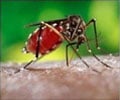The researchers found inherent size differences between the mosquito species. The treehole mosquito is larger than the Asian tiger mosquito, which makes it less vulnerable to predation
The researchers found inherent size differences between the mosquito species. The treehole mosquito is larger than the Asian tiger mosquito, which makes it less vulnerable to predation from the small but voracious predatory midge. Previous studies have found that the native mosquito larvae also adopt less "risky" behaviors than the invasive mosquito larvae, making them less susceptible to being eaten.
"Size is having a major effect in terms of how the prey are getting consumed," said Barry Alto, a medical entomologist with the State Natural History Survey at the University of Illinois and principal investigator on the study."This is another mechanism that allows the native mosquito to hang on and co-exist with the invasive mosquitoes in certain areas where predators are present," Alto said.
The Asian tiger mosquito was first detected in the U.S. in 1985 in a shipment of used tires to a Texas port. Like the native mosquito, it lays its eggs in watery containers, including tires. Even if the water evaporates, a splash of rain and a supply of nutrients such as the microbes that feed on dead leaves are all that the larvae need to hatch and grow.
Once found only in tropical and subtropical regions of Southeast Asia, the Asian tiger mosquito has now spread to Africa, the Americas, Australia, the Caribbean, Europe and the Middle East. Like the yellow fever mosquito (Aedes aegypti), another invasive mosquito that is now well established in the Americas, the Asian tiger mosquito can carry several viral diseases that afflict humans.
Source-Eurekalert
SRM









